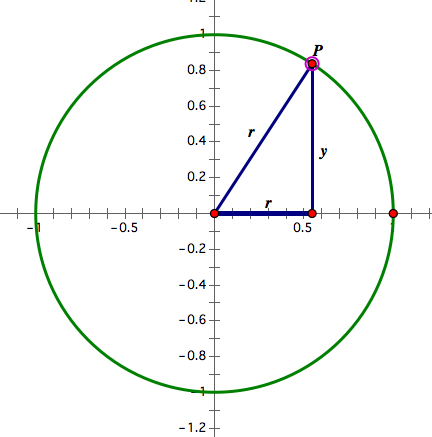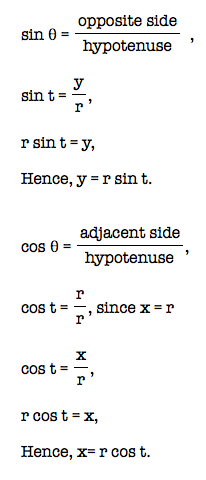Parametric Equations
By: Lacy Gainey
Graph the parametric equations 

I would recommend using graphing calculator software (such as Graphing Calculator 3.4 or 4), so you can more easily observe the parametric curves.
Notice that the parametric equations produced a circle with a radius of 1.
Up until this point, students may have only been exposed to this equation of a circle: [1 GSP], where the circle is centered at the origin and r is the radius of the circle.
-
How did we get from  to
to  ?
?
We can use our knowledge of right triangles and trigonometry to derive the parametric equations  .
.
Observe the diagram below.

In a right triangle, recall that  . In the diagram, we are letting t = θ. t is our parameter.
. In the diagram, we are letting t = θ. t is our parameter.
Observe,

So point P in the diagram is equal to (r cos(t), r sin(t))
-
Graph the parametric equations  , using different values for r and observe what happens. Use the same value for r in both equations.
, using different values for r and observe what happens. Use the same value for r in both equations.
I graphed  , for 0 ≤ r ≤ 20.
, for 0 ≤ r ≤ 20.
We can see that as r increases, the diameter of the circle increases. As r approaches 0, the diameter of the circle decreases.
-
What do you think will happen if we use different values of r for each of the parametric equations?
-
I chose to graph 

and 

So when we use different values for each of the parametric equations, it seems that an ellipse is formed.
For further exploration graph  , for different values of a and b and observe what happens.
, for different values of a and b and observe what happens.



to
?
.
. In the diagram, we are letting t = θ. t is our parameter.
, using different values for r and observe what happens. Use the same value for r in both equations.
, for 0 ≤ r ≤ 20.
, for different values of a and b and observe what happens.